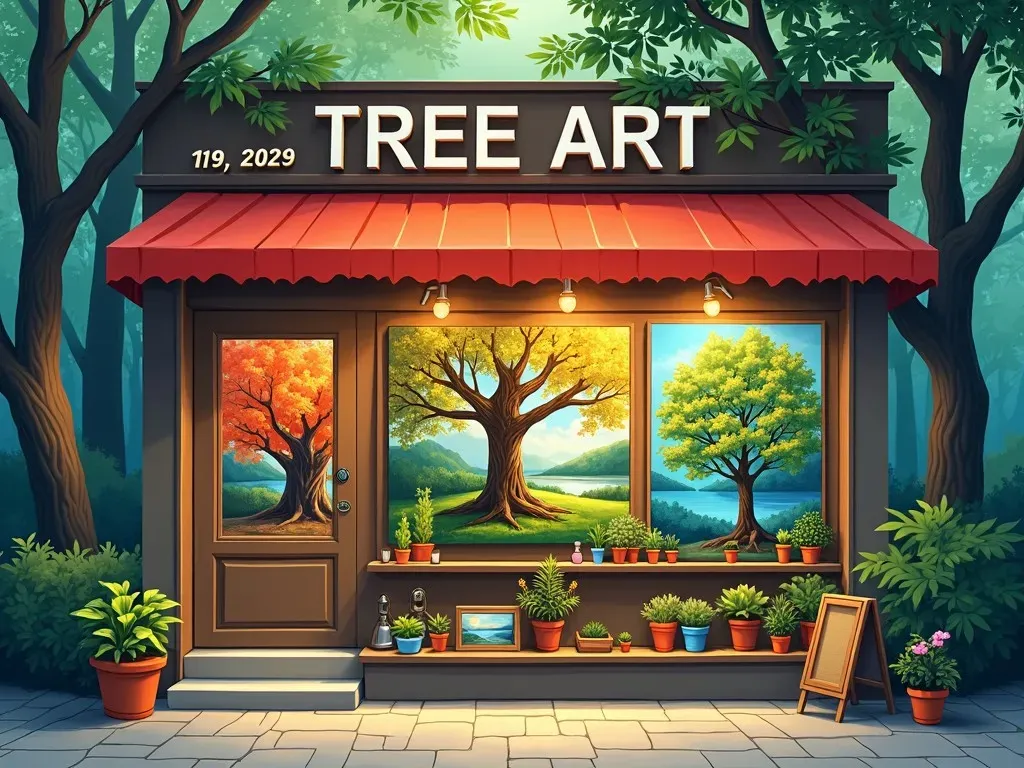When it comes to embracing the beauty of nature, paintings of trees on canvas hold a special place in the hearts of art collectors and enthusiasts. The serene allure of trees, captured artistically on canvas, offers a glimpse into the intricate details of the natural world, bringing both tranquility and vibrancy into home and office spaces.
Whether it’s the rustling leaves of a mighty oak or the delicate blossoms of cherry trees, these artworks encapsulate the essence of nature. They invite viewers to experience the changing seasons, the dance of light, and the vibrant colors that each specimen offers.
Why Choose Paintings of Trees on Canvas?
Beauty and Versatility
Paintings of trees on canvas come in various styles, colors, and Techniques. Artists employ different methods, from abstract to realistic portrayals, allowing for a myriad of interpretations of tree-themed art. The versatility to blend seamlessly into any decor style makes tree paintings a favored choice for homeowners and art lovers alike.
| Art Style | Description | Example Colors |
|---|---|---|
| Abstract | Uses shapes and colors to represent trees | Bold reds, deep blues, and greens |
| Realistic | Life-like representation | Natural greens, browns, and greys |
| Impressionistic | Captures the essence of trees with brush strokes | Pastels, soft shades of colors |
Connection with Nature
Trees are often symbols of strength and resilience, standing tall and weathering storms. Art that portrays trees can serve as a reminder of these qualities, creating a comforting ambiance. Additionally, studies suggest that nature-themed art can enhance mood and reduce stress levels, making paintings of trees on canvas not just decorative, but also beneficial to mental health.
Popular Types of Tree Paintings on Canvas
-
Forest Landscapes: Lush forests painted in varying shades of green can transport viewers to a tranquil setting.
-
Single Tree Portraits: These artworks often focus on a singular, majestic tree, emphasizing its unique characteristics.
-
Seasonal Representations: Artists often create paintings depicting trees in various seasons, showcasing the vibrant colors of fall or the delicate blooms of spring.
-
Abstract Tree Art: Using non-representational forms, this style encourages individual interpretation while maintaining a connection to trees through color and texture.
-
Mixed Media: Incorporating various materials adds depth and interest to tree paintings, making them visually captivating.
The Impact of Color
The color palette utilized in paintings of trees on canvas profoundly affects their mood and ambiance. Here’s how specific colors evoke feelings:
| Color | Emotion |
|---|---|
| Green | Calmness and renewal |
| Brown | Stability and comfort |
| Red | Passion and energy |
| Blue | Serenity and tranquility |
| Yellow | Happiness and warmth |
famous tree paintings and Their Artists
Artists throughout history have drawn Inspiration from trees. Here are a few notable examples:
| Artist | Artwork | Year | Description |
|---|---|---|---|
| Gustav Klimt | "The Tree of Life" | 1905 | Symbolizes growth and renewal. |
| claude monet | "The Japanese Bridge" | 1899 | Captures the beauty of trees reflecting in water. |
| Vincent van Gogh | "Olive Trees" | 1889 | Showcases the vibrant colors of olive groves. |
| Georgia O’Keeffe | "The Tree" | 1920s | An abstract representation of the natural form of a tree. |
Where to Find Stunning Tree Art Online
The digital world offers numerous platforms to explore and purchase amazing tree paintings on canvas. Here are a few recommended sites:
- Etsy: A marketplace for original artworks, including 3D textured tree paintings and more.
- iCanvas: Offers a wide variety of tree wall art and canvas prints in different artistic styles.
- Art.com: Features extensive collections of tree wall art with multiple filtering options for personalized searches.
- Great Big Canvas: Provides a diverse selection of tree art for every season and artistic taste.
Caring for Your Tree Paintings
To ensure the longevity of your paintings of trees on canvas, consider the following tips:
- Location: Avoid direct sunlight to prevent fading.
- Cleaning: Dust regularly with a soft cloth; avoid moisture to prevent mold.
- Framing: Consider framing under glass to provide an additional layer of protection.
- Humidity Control: Maintain a stable environment, avoiding extreme humidity or dryness.
FAQ
What are the different styles of tree paintings on canvas?
Tree paintings can vary greatly in style, such as abstract, realistic, impressionistic, or even surreal. Each style offers a unique interpretation of trees and nature.
How do I choose the right tree painting for my space?
Consider the size, color palette, and style that blend well with your existing decor. A large, striking piece can serve as a focal point, while smaller artworks may complement the room.
Can paintings of trees on canvas improve my mood?
Yes, research has shown that nature-themed art can reduce stress and improve well-being, making it a beautiful way to enhance your living space.
Are there online communities for tree painting enthusiasts?
Yes, social media platforms such as Instagram and Pinterest, as well as art-focused forums, provide spaces for enthusiasts to share, discuss, and celebrate tree art.
How can I learn to paint trees myself?
Many online resources, including YouTube tutorials and online classes, can teach various techniques to paint trees. Start with simple shapes and gradually advance to more complex forms.
By immersing yourself in the enchanting world of paintings of trees on canvas, you invite not just art, but a piece of nature into your home, capturing the timeless beauty that trees embody.
